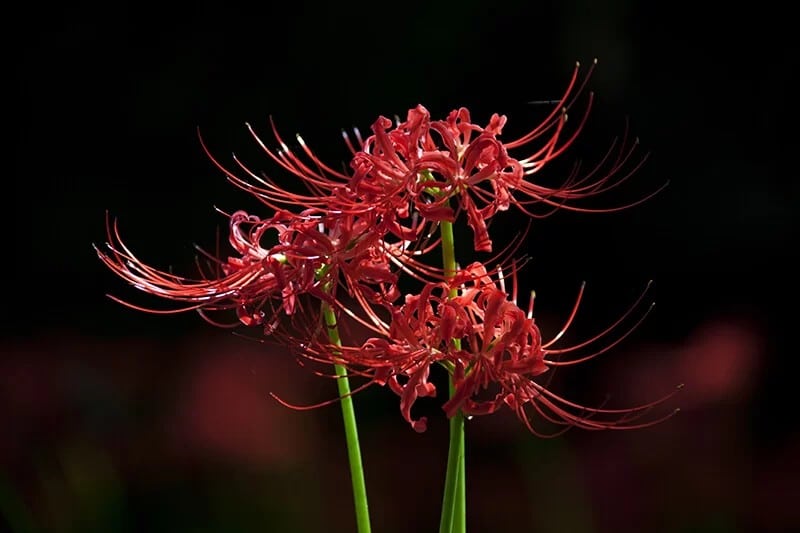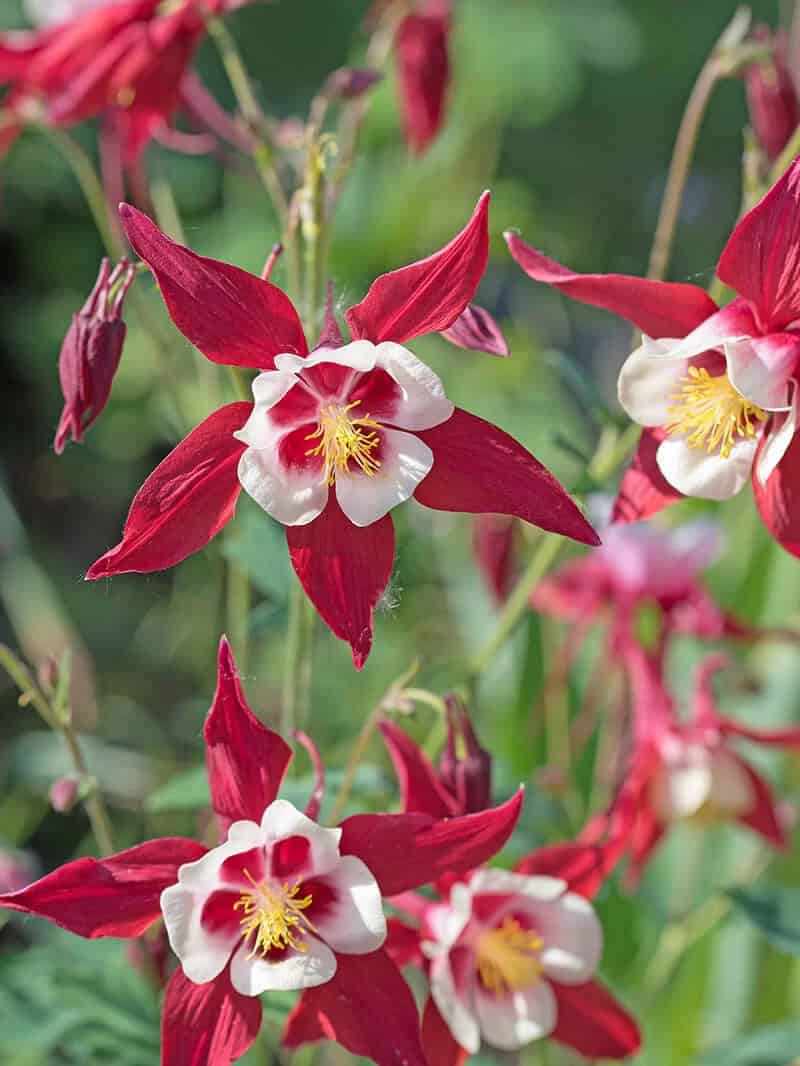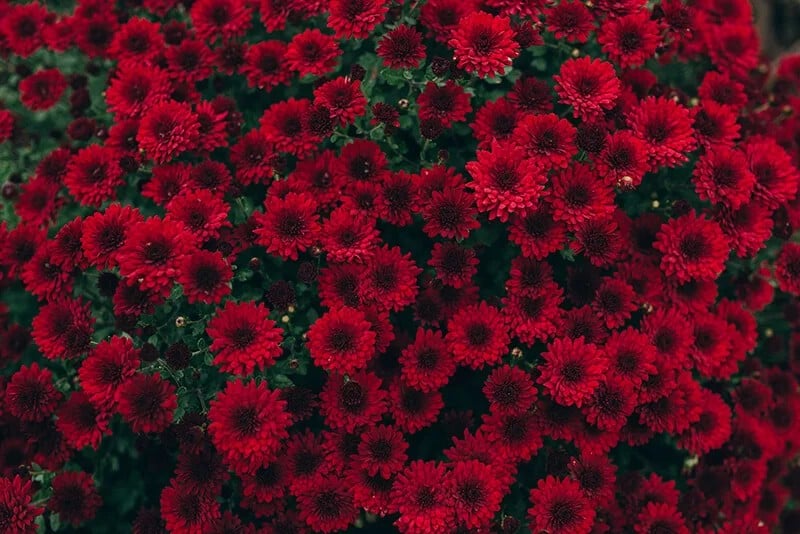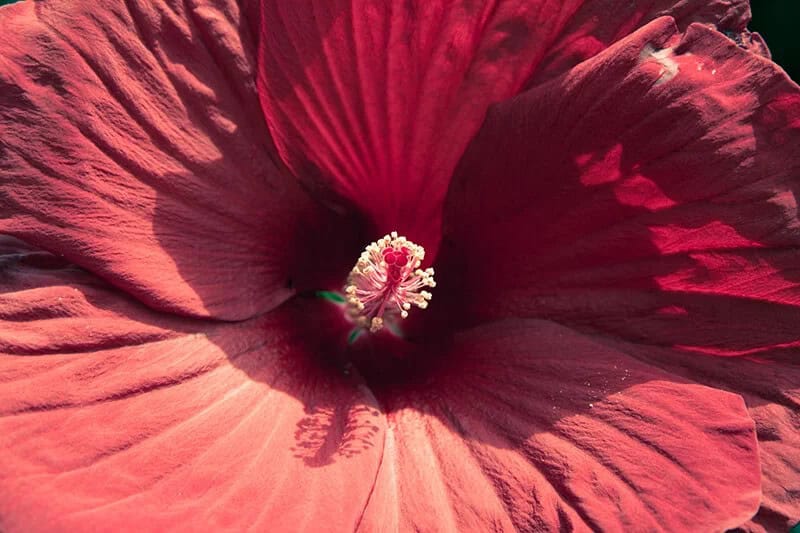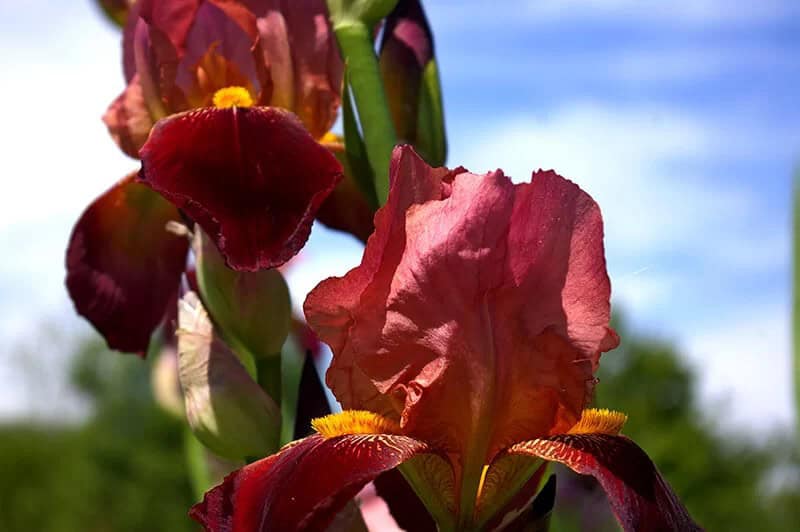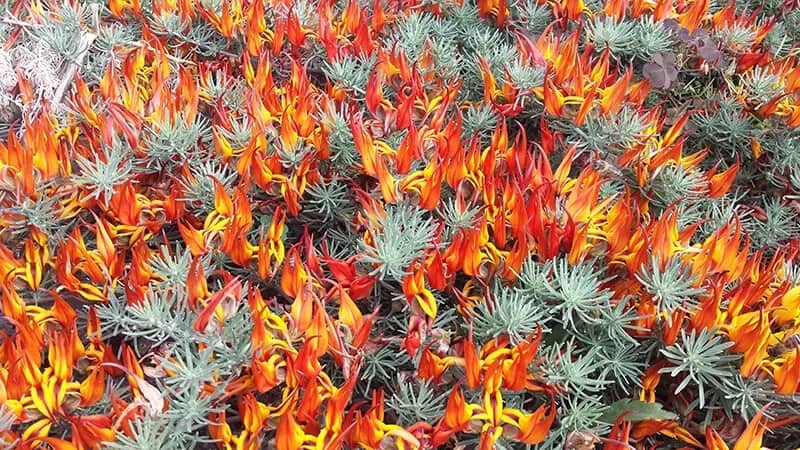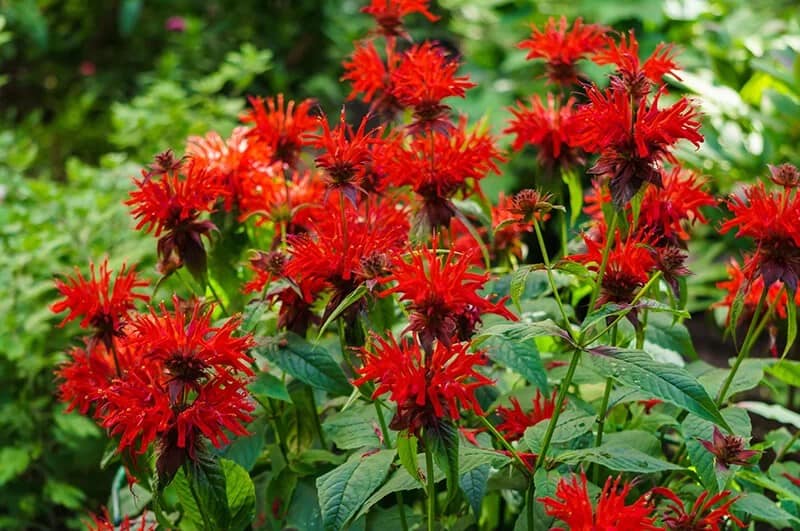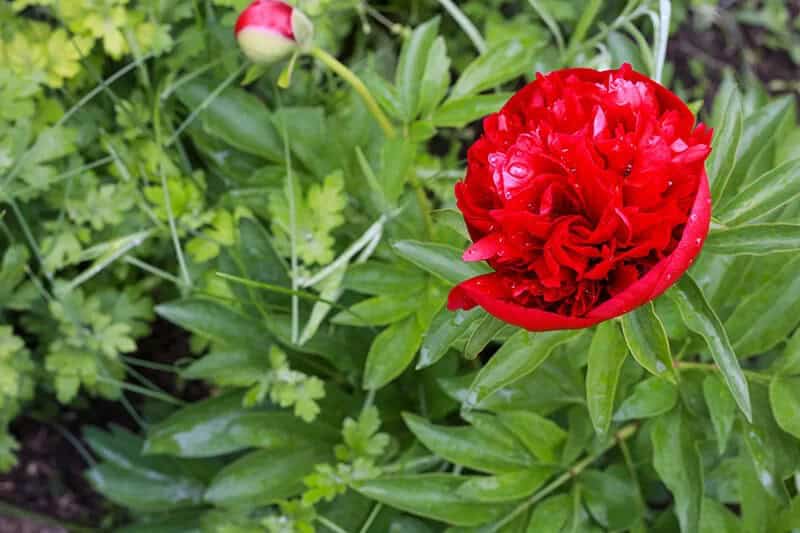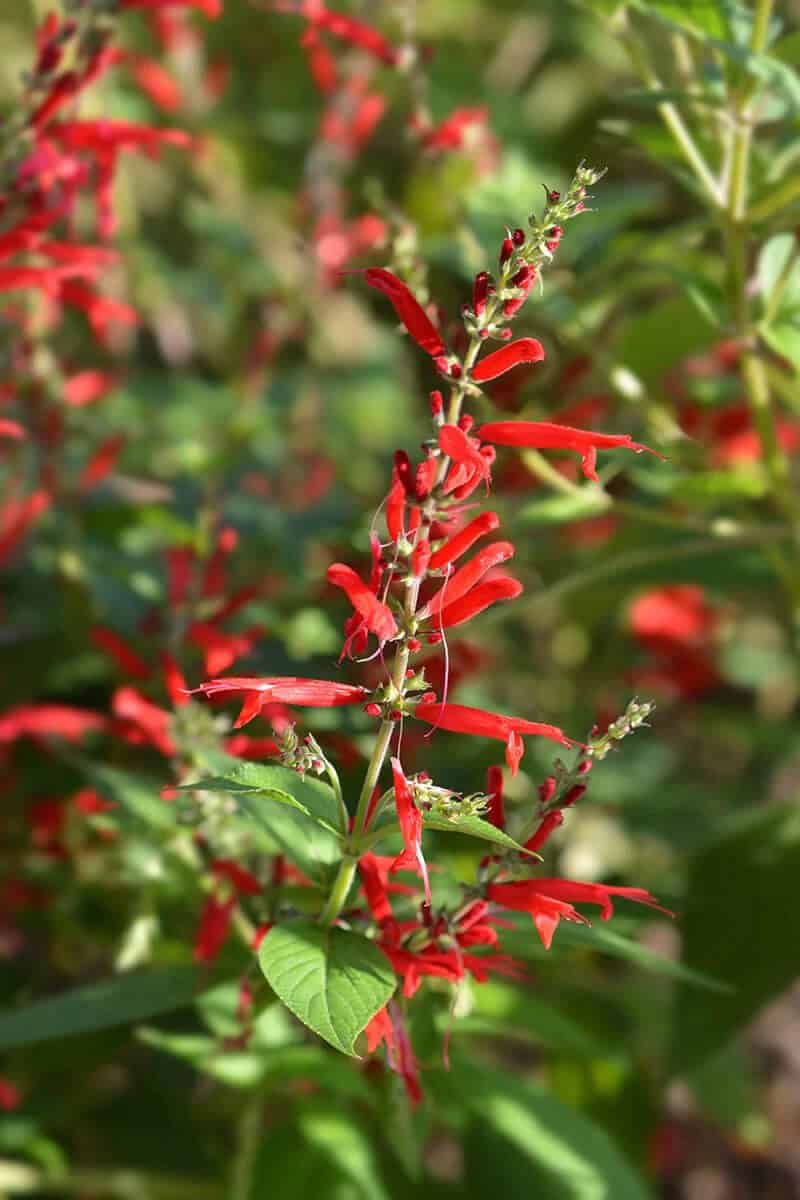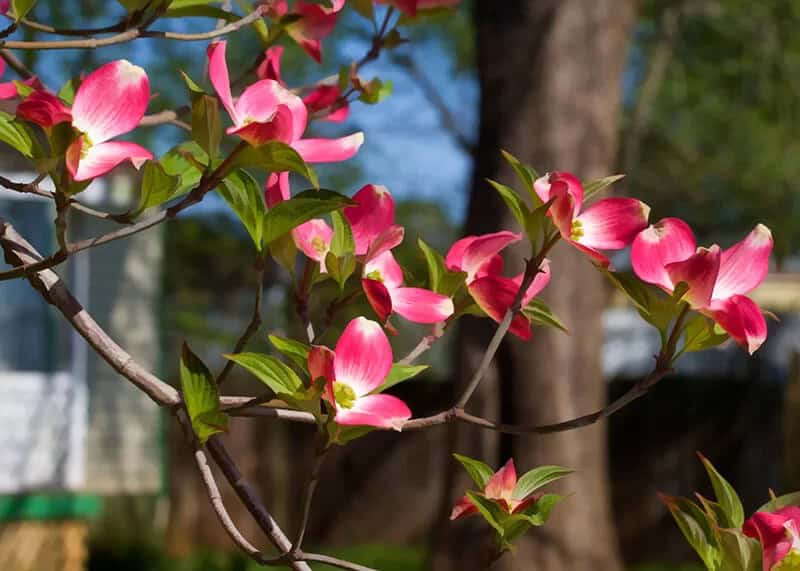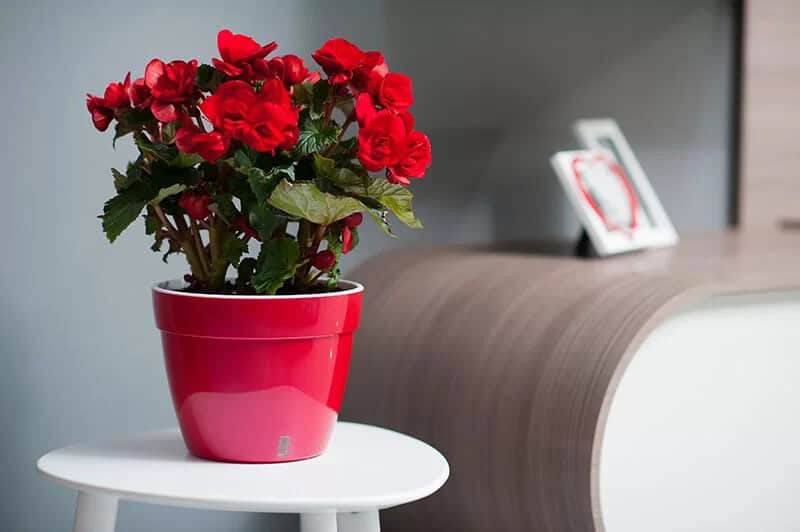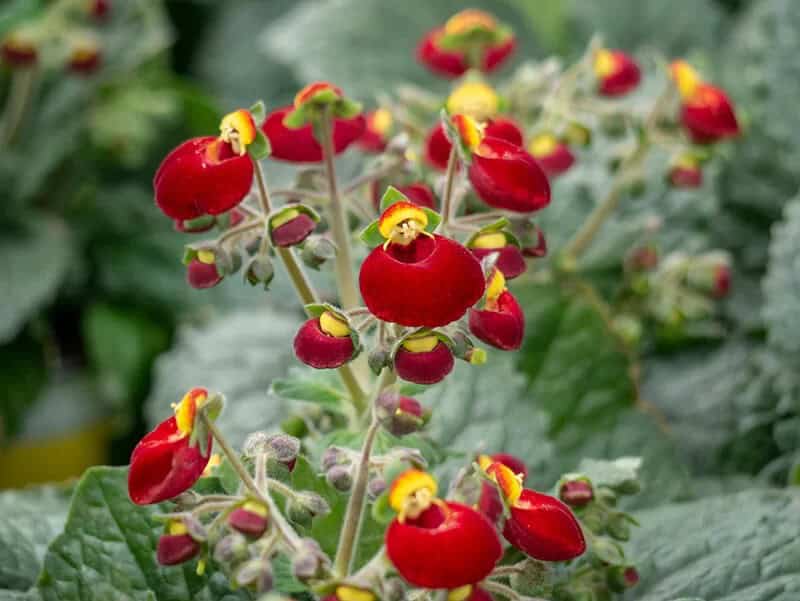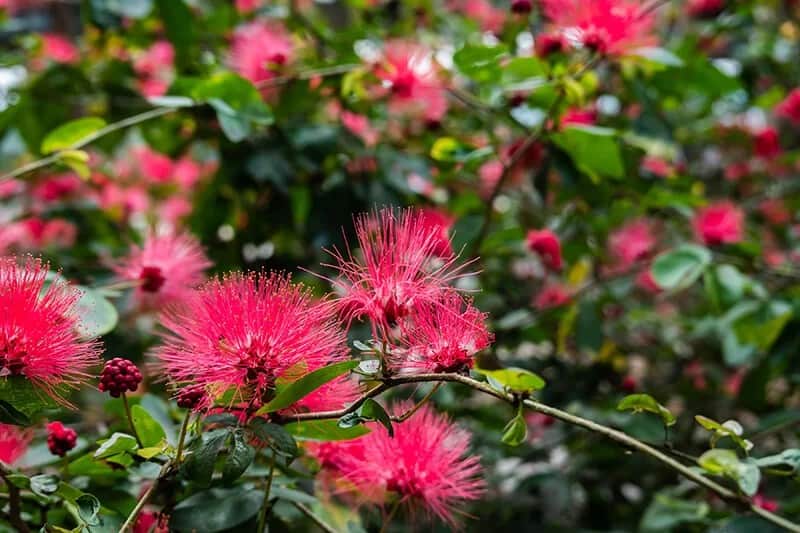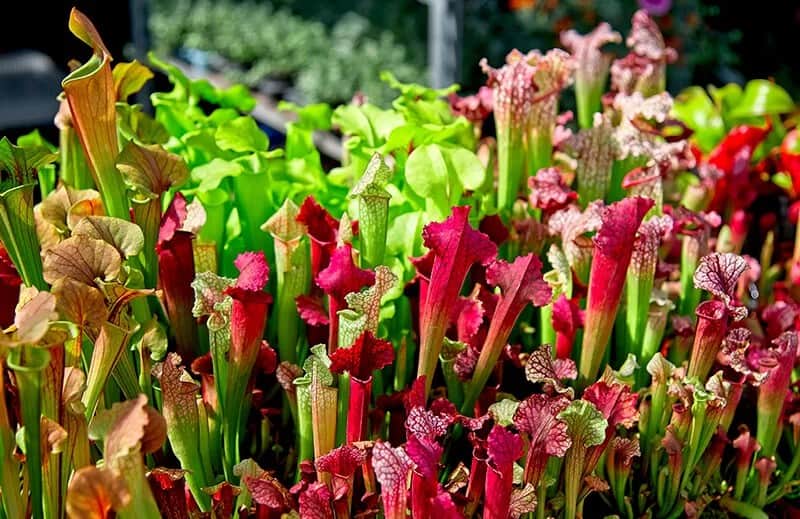Transforming your outdoor space into an eye-catching haven is as simple as planting a sea of vibrant red flowers. This captivating color not only delights human senses but also serves as a powerful attractant for pollinators like hummingbirds, bees, and butterflies. By focusing exclusively on red blooms, you can create a breathtaking display of uniform beauty. Alternatively, layering red with other colors adds depth and variety to your garden.
With countless options available, you’re sure to find the perfect shade of red to suit your style. And when winter arrives, bring your red flower plants indoors to continue basking in their dazzling presence all year round.
27 Meaningful Red Flowers to Plant in Your Garden and Take it to the Next Level
Crape Myrtle (Lagerstroemia ‘Country Red’)
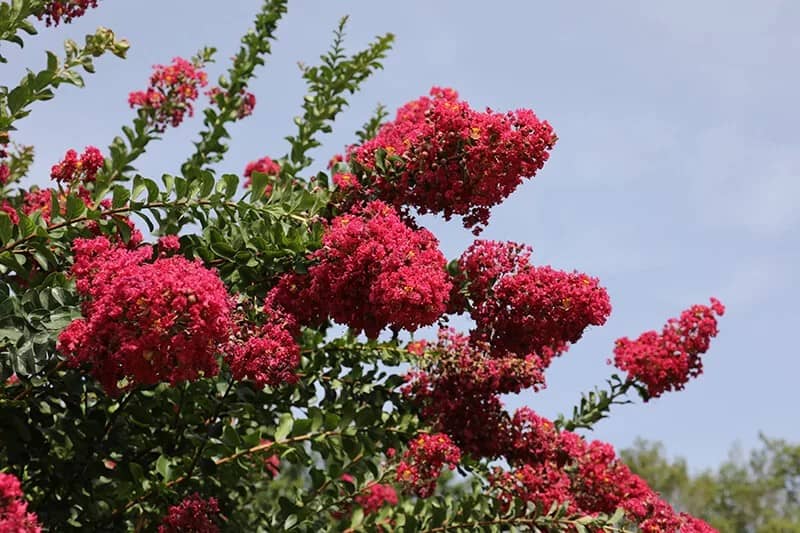
Crape Myrtles are renowned for their stunning floral displays, making them an excellent choice for many garden designs. This particular variety boasts vibrant red blooms and dark green foliage. One of its notable features is its ability to adapt to different environments, with growth size influenced by the severity of winter temperatures. In milder climates, a crape myrtle can reach up to 10 feet in height, making it an ideal addition to any garden seeking a dramatic statement piece.
Spider Lily (Lycoris Radiate)
The Spider Lily’s striking features are characterized by its slender red stamens, which form an arc shape that sets the flower apart from others in its class. This unique appearance is also tied to the plant’s symbolic significance, as it blooms during the autumn equinox, marking a time of transition and new beginnings. Growing conditions for the Spider Lily require medium watering needs, well-drained soil, and full sun to part shade exposure.
Its growing zones range from 6 to 10, making it suitable for a wide geographic area. The plant’s blooming season typically takes place in August and September, during which time its elegant flowers can be enjoyed.
Yarrow (Achillea Millefolium ‘Paprika’)
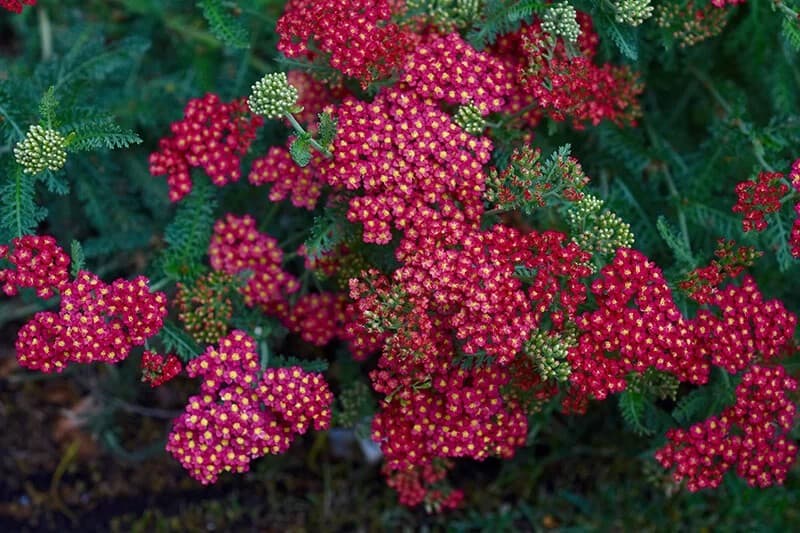
Yarrow’s whimsical blooms evoke an enchanted mist, as if sprinkled with magic dust. This herbaceous charm boasts not only visually stunning flowers but also carries medicinal properties. Among its many varieties, ‘Paprika’ stands out for its dusty rose petals and fragrant leaves. When used in dried arrangements, Yarrow’s aroma wafts through the senses, an olfactory delight to complement its visual allure.
Its unique characteristics include a need for dry to medium water levels, average soil that can tolerate poor drainage, and a thriving environment within growing zones 3-8, basking in full sun from June to September.
Columbine (Aquilegia ‘Red Hobbit’)
The Columbine, with its whimsical folds and delicate structure, has evolved to captivate pollinators through every aspect of its artful petals. One striking feature is its ability to attract hummingbirds when grown with red flowers. While columbines come in a wide range of hues, the ‘Red Hobbit’ variety stands out for its unique two-toned petals offering an attractive contrast.
This charming perennial thrives in medium water conditions and can grow in any soil except those that are heavy or poorly drained. Columbine is hardy in zones 3 to 8 and requires full sun to part shade. Blooming season typically occurs from April to May, making it a delightful addition to any garden.
Chrysanthemum (Chrysanthemum ‘Yoraquel’ Raquel)
Chrysanthemums are a staple of autumn gardens, boasting luscious blooms that last from September until the first frost. These hardy plants thrive in well-drained soil and full sun, making them a great addition to any outdoor space. While often found in containers, chrysanthemums can also be planted directly in the ground and overwinter if the conditions are right.
The moody maroon flowers of this variety may not be suitable for every garden, but rest assured that there are plenty of other red shades to choose from.
Coneflower (Echinacea Purpurea ‘Balsomsed’ Sombrero Salsa Red)
Coneflowers, with their striking red flowers and central cones, are a beloved addition to any pollinator garden. Native to North America, these drought-tolerant plants thrive in well-drained soil and full sun. Butterflies and birds alike flock to the picturesque blooms, making them a perfect choice for attracting wildlife. While the main blooming season typically runs from June to August, occasional flowers may still appear until frost sets in.
With growing zones ranging from 3 to 8, coneflowers are suitable for many regions. Their symbolism is rooted in strength and healing, adding an extra layer of significance to their presence in your garden.
Hardy Hibiscus (Hibiscus ‘Cranberry Crush’)
When it comes to adding some feminine flair to your garden, few flowers can rival the beauty and grandeur of the hibiscus. This stunning plant boasts delicate, trumpet-shaped blooms that can reach an impressive 10 inches in diameter. If you’re looking for a flower that thrives in moist environments – perfect for rain gardens or areas where water tends to collect – then the hardy hibiscus is an excellent choice.
Just be sure to provide it with full sun and temperatures ranging from zones 4 to 9, as well as medium to wet soil conditions. To encourage repeat blooms throughout the summer months (July to September), make sure to regularly deadhead the old flowers. With a little TLC, you’ll be rewarded with a stunning display of vibrant red blooms that are sure to impress.
Tall Bearded Iris (Iris ‘Dutch Chocolate’)
The ‘Dutch Chocolate’ iris stands out from the typical springtime flowerbeds filled with pastel hues, thanks to its vibrant red and intense chocolate coloration. But what truly sets it apart is its striking height – some varieties can reach up to 40 inches tall. When in bloom, this showstopper of an iris is sure to spark conversations. With its symbolism tied to friendship, hope, and valor, the ‘Dutch Chocolate’ is a stunning addition to any garden.
To thrive, it requires medium watering with the ability to adapt to drought once established, as well as sandy, well-drained soil. It can be grown in zones 3-9 and prefers full sun. The blooming season typically takes place from May to June.
Parrot’s Beak (Lotus Berthelotii)
Parrot’s beak is an eye-catching addition to any garden or indoor space. Its unique features include silvery foliage that creates a striking contrast against its vibrant yellow flowers, which are adorned with bright red tips. This tropical plant thrives in well-drained sandy soil and full sun. While it typically grows best in zones 10-12, it can still be cultivated in containers elsewhere if the potting mix is combined with sand.
Bee Balm (Monarda ‘Gardenview Scarlet’)
The bee balm plant, with its vibrant red blooms, is a striking addition to any garden. Not only does it boast an eye-catching appearance, but it also plays a crucial role in attracting pollinators such as hummingbirds, bees, and butterflies. The ‘Gardenview Scarlet’ variety features tubular red flowers that resemble a landing strip for these visiting insects. To maintain its visual appeal throughout the growing season, it’s essential to remove spent blooms regularly.
In terms of its needs, bee balm thrives in environments with medium to wet soil conditions, moderate watering, and full sun to partial shade. It’s hardy in zones 4 to 9, making it a suitable choice for many gardeners.
Peony (Paeonia ‘Red Charm’)
The ‘Red Charm’ peony is a stunning addition to any flower garden, imbued with symbolic meanings of prosperity, honor, and romantic happiness. This fragrant bloom requires well-drained soil and medium water levels, making it an ideal choice for zones 3 to 8. With full sun to part shade conditions, these flowers will thrive in your outdoor space. While the blooming period is relatively short, lasting around 7-10 days in May, the resulting display is truly breathtaking.
To ensure a lush and varied flower bed, consider planting ‘Red Charm’ alongside other peony varieties that bloom at different times to avoid bare spots.
Poppy (Papaver Bracteatum)
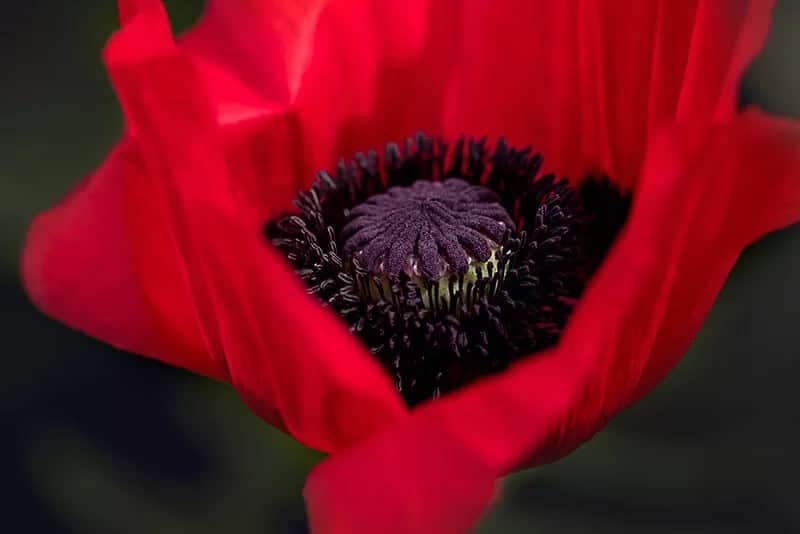
Poppies, with their striking dark eye and vibrant scarlet petals, are instantly recognizable as one of the most iconic types of red flowers. But beyond their striking appearance, these blooms hold a deeper significance – they’ve long been associated with joy, peace, and remembrance for those who never returned from war. To bring this symbolic beauty to your garden, you’ll need to provide poppies with the right conditions: medium water needs, well-drained soil, and full sun to part shade.
With growing zones ranging from 4 to 9, these flowers can thrive in a variety of environments. If you’re eager to witness their stunning May blooms, be sure to give them a period of cold winter dormancy, which will help them reach their impressive 8-inch heights.
Garden Phlox (Phlox Paniculata ‘Red Riding Hood’)
Phlox ‘Red Riding Hood’ is a standout choice for any gardener, regardless of experience level. This charming perennial boasts vibrant, cherry-red flowers that form impressive clusters, exuding an inner radiance that’s hard to ignore. With its medium water requirements, well-drained soil, and tolerance for full sun to part shade, ‘Red Riding Hood’ is surprisingly easy to grow.
Its blooming season typically runs from July to September, making it a reliable choice for adding a pop of color to your garden during the warm summer months.
Pineapple Sage (Salvia Elegans)
Pineapple sage is a versatile herb that offers more than just its flavorful foliage. Its tubular flowers are also a stunning addition to any arrangement – imagine them as a colorful garnish for your favorite cocktail! The leaves, too, can be used in creative ways like potpourri mixes or other craft projects. Despite not being hardy enough to overwinter in colder climates, this plant is easily adaptable, thriving in containers or treated as an annual.
With its medium water needs, well-drained soil, and full sun requirements, pineapple sage does best in growing zones 8-10, where it blooms from August to October.
Lipstick Plant (Aeschynanthus Radicans)
The lipstick plant is a unique and exotic addition to any garden. Its striking, tube-shaped flowers evoke the vibrant hues of a well-applied lipstick. While it does require some extra care in terms of soil preparation – mixing sphagnum into the potting mix – this vine is surprisingly easy-going once established. In fact, its low-maintenance nature makes it an ideal choice for busy gardeners or those new to the world of botany.
When planted in hanging baskets, the lipstick plant’s vines can be trained to cascade down, creating a dramatic and eye-catching display. To thrive, this tropical beauty requires medium watering, partial shade to full shade, and temperatures between 10-11 growing zones.
Red Passion Flower (Passiflora Coccinea)
The Red Passion Flower – A Vibrant Addition to Your Container Garden While its symbolic connotations evoke mourning and suffering, the stunning red passion flower (Passiflora suberosa) is an ideal choice for adding a pop of color to your container garden. This ornamental beauty thrives in medium water conditions and well-drained soil, making it suitable for a wide range of gardening scenarios.
When the temperature cools down, bring your potted passion flower indoors to ensure its continued health. If you reside in USDA Hardiness Zones 10 or warmer, be prepared for the possibility of harvesting a delicious passion fruit from your very own vine. With its full sun to part shade light requirements and blooming period spanning July to September, this show-stopping red flower is sure to captivate anyone who lays eyes on it.
Hybrid Tea Rose (Rosa ‘Jacopper’ Veterans’ Honor)
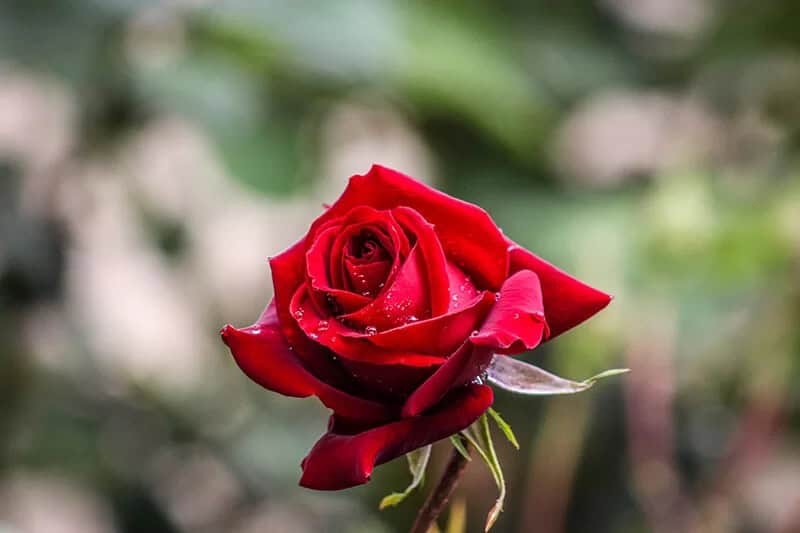
Roses are often considered the crown jewels of red flowers, with their iconic, long-stemmed blooms exuding timeless elegance. While they may require a bit more TLC and pruning to keep them thriving, the payoff is well worth the extra effort. To showcase their romantic charm, consider planting this variety as a loose hedge, adding a touch of sophistication to your outdoor space.
This particular type of rose thrives in conditions characterized by medium water needs, well-drained soil, full sun exposure, and a growing zone ranging from 5 to 9. Its blooming season typically stretches from May until the first frost, with its vibrant red hue adding a pop of color to any setting.
Flowering Dogwood (Cornus Florida ‘Red Pygmy’)
The flowering dogwood tree, native to North America, boasts stunning beauty and symbolic strength. This particular variety stands out with vibrant red flowers adorned by striking white markings, offering a breathtaking display. While most varieties produce white blooms, this unique specimen adds an extra layer of charm. Beyond its showy appearance, the tree also produces fruit in late summer and early fall that serves as a vital food source for birds.
With optimal growing conditions of medium water needs, well-drained soil, and full sun to part shade, flowering dogwoods thrive in zones 5 through 9. A true ornamental gem, this tree is sure to captivate attention.
Begonia (Begonia ‘Bepared’ Dragon Wing Red)
Begonias are often sought after for their low-maintenance nature, making them an ideal choice for novice gardeners. When it comes to symbolism, begonias convey a sense of cautiousness – a quality that’s particularly valuable in a world where we’re constantly learning and adapting. As for growing conditions, begonias require medium watering, but they’re surprisingly drought-tolerant. They thrive in moist, well-drained soil, and can be grown in zones 10 to 11.
In terms of light, they prefer part shade to full shade, which makes them perfect for areas that receive indirect sunlight. Begonias produce vibrant blooms from May until the first frost, with scarlet flowers being a standout feature of this variety. As an added bonus, begonias can be easily brought indoors during the winter or treated as annuals, making them a versatile choice for gardeners in cooler climates.
Slipper Flower (Calceolaria Herbeohybrida Group)
The slipper flower is a stunning addition to any container garden, offering a sense of accomplishment when its cushiony blooms come into view. With rich red petals featuring yellow accents, this unique flower adds visual interest to the arrangement. As an experienced gardener, you may be eager to take on the challenge of cultivating this temperamental yet rewarding bloom. To thrive, slipper flowers require medium watering needs and well-drained soil.
They prefer part shade to full shade and can grow in zones 10 to 11. The seasonal blooming period adds a touch of variety to your garden, making it a great choice for those looking to create a dynamic display.
Powder Puff Tree (Calliandra Haematocephala)
The powder puff tree’s vibrant beauty is not just skin-deep – its symbolism runs deep too. As a medium-watered and moist-soil-loving plant, it thrives in zones 9 to 11, basking in full sun. But what truly sets it apart are the joyful crimson puffs that erupt from its branches, unlike most flowers which have delicate petals. Instead, the powder puff tree’s ‘blooms’ take the form of a feathery mass of stamens, creating a mesmerizing display.
Whether planted directly into warm soil or thriving in containers elsewhere, this stunning specimen is sure to bring delight.
Tulip (Tulipa)
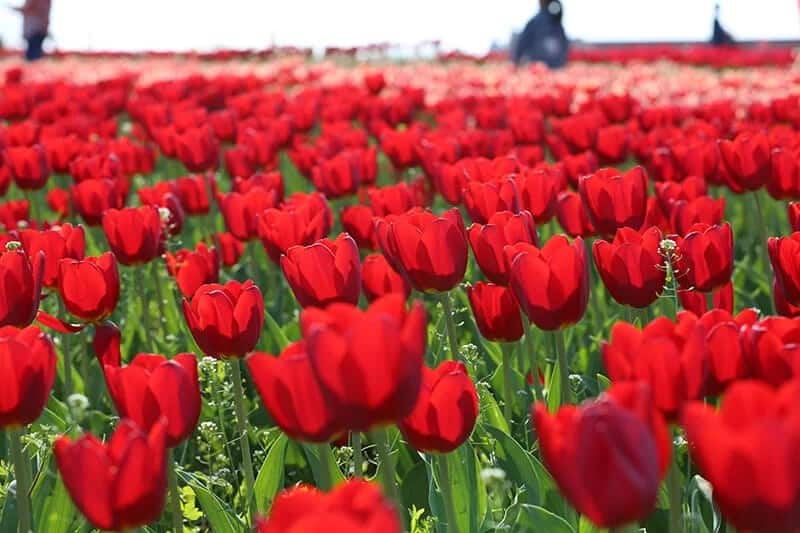
Tulips, with their striking red hues, bring a touch of magic to any landscape when planted as accents or in fields. Not only do they offer vibrant blooms, but some varieties feature stunning variegated petals that add depth and complexity to their beauty. As a bonus, tulips tend to perform best during their first two years before gradually declining, making them often treated as annuals.
When it comes to growing conditions, tulips prefer medium water needs, well-drained soil, and full sun exposure in zones 3 to 8. In terms of blooming seasons, April to May typically see the most spectacular displays of color.
French Marigold (Tagetes Patula)
Marigolds are often synonymous with vibrant yellow hues, but this variety is not the only story. In fact, red and bicolor marigolds exist, boasting a deep burgundy shade that beautifully complements bright yellows. As symbols of grief and jealousy, these flowers hold more significance than just their aesthetic appeal. With medium water needs, well-drained soil, and a growing zone range of 2 to 11, marigolds are an accessible choice for gardeners of all levels.
They thrive in full sun and bloom from June until frost, provided prompt deadheading is practiced to encourage a profuse display of fluffy flowers.
Blanket Flower (Gaillardia Aristata ‘Arizona Sun’)
The symbolism behind the blanket flower is rooted in its ability to evoke feelings of modesty, charm, happiness, and joy. Its water needs are relatively moderate, thriving in conditions that range from dry to medium moisture levels. The soil should be well-drained, although it can tolerate some dryness. This adaptable plant can flourish in a wide range of growing zones, spanning from 3 to 10. In terms of light, the blanket flower requires full sun exposure to reach its full potential.
Blooming seasonally from May to August, this vibrant flower is sure to brighten up any garden or patio space. As a native North American plant, the blanket flower is an excellent choice for pollinator gardens. The award-winning ‘Arizona Sun’ variety boasts striking yellow-tinged red petals, making it an attractive addition to borders or containers. To encourage prolonged flowering, regular deadheading is essential.
Pitcher Plant (Sarracenia ‘Judith Hindle’)
The pitcher plant is a fascinating addition to any landscape, not only because of its striking appearance but also due to its unusual carnivorous nature. The showy red flowers that bloom in the spring are a definite conversation starter, while mature plants display deep red pitchers. However, this unique species has specific soil requirements that cannot be met by standard potting mix. Instead, it thrives when planted in well-draining media that caters to its needs.
The Top 27 Best Red Flowers to Spice Up Your Garden
Beyond their vibrant appearance, red flowers can bring a wealth of significance to your surroundings. From expressions of eternal love to symbols of healing and rejuvenation, cultivating flowers that resonate with your personal journey can be a powerful way to connect with nature and yourself. While many flower meanings have been established over centuries, don’t be afraid to forge your own path by defining the symbolism behind the red blooms you choose for your space.
To maximize their impact, consider staggering the bloom times of your chosen red flowering plants, ensuring that you can enjoy vibrant displays throughout the year.
